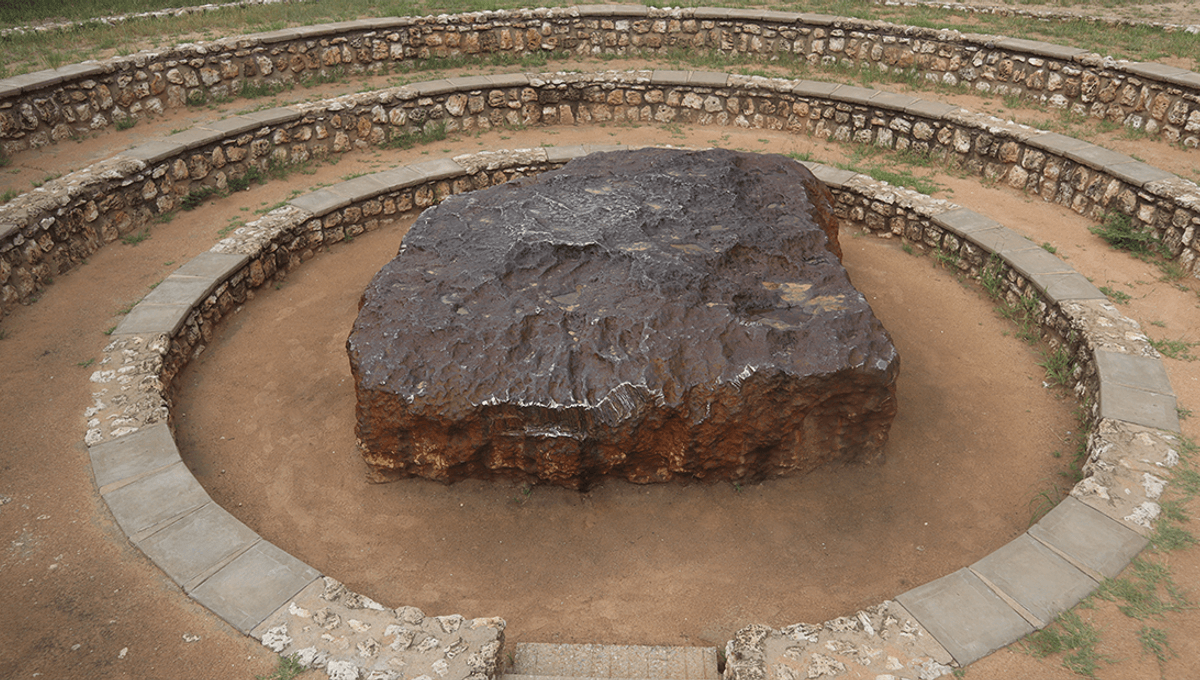
In 1920, a farmer plowing a field in Grootfontein, Namibia, hit a sudden roadblock below the surface of the soil. Curious about what had stopped his plow, the farmer dug around and found a very strange sight.
ADVERTISEMENT GO AD FREE
Beneath the soil was a giant slab of metal. In fact, at 60 tons, it turned out to be the largest meteorite that has ever been found on the Earth’s surface. The meteorite was found to be about 84 percent iron, 16 percent nickel and other elements. While a cool and valuable find, what was really weird about it was its unusual flat shape and almost complete lack of an impact crater.
The latter aspect was the most puzzling, warranting further investigations. When meteorites hit the ground, even teeny tiny ones, they tend to make an impressive impact. So why was this meteorite – named the Hoba meteorite after the Hoba West farm where it was found – simply lying there underneath a shallow layer of soil? It could only mean one of two possibilities.
“With respect to its fall, we can say with confidence that the Hoba meteorite was either derived from a single, non-fragmenting parent body, or it is just the first found fragment, and not necessarily the largest fragment, in what is presumably a large and yet to be described strewn field produced by a disintegrated parent body,” scientists investigating the meteorite wrote in a 2013 paper.
“In addition, the absence of any accompanying impact features, in the modern era and indeed recorded history, implies that the meteorite was either transported from its original fall location, which seems highly unlikely, or that the fall circumstances were such that any initial impact signatures have now been eroded away. Both fall scenarios are interesting, and both have associated problem issues with explaining what is actually known about the meteorite.”
The meteorite, an approximately square slab 2.7 meters (8.9 feet) in length and width, and 0.9 meters (3 feet) thick, doesn’t show significant signs of cracking either. However, there were a few other clues to its origin, and apparent safe passage to the Earth’s surface.
ADVERTISEMENT GO AD FREE
“The meteorite has suffered some considerable surface contact alteration, having developed a thick 20 to 30-cm [7.9 to 11.8-inch] iron-shale base where it contacts the underlying Kalahari limestone,” the team continued. “Based upon 59Ni radionuclide studies McCorkell et al. (1968) deduce a terrestrial residency time of less than 80,000 years. This relatively long, by human standards, residency time clearly dictates that, sadly, no written or even ethno-historic record of its actual fall will ever be found.”
While a lack of historical documentation is disappointing, unless we’ve got something very wrong, the laws of physics remained the same 80,000 years in the past. As such, physicists can model scenarios that would produce a giant slab of meteorite sitting in a teeny tiny crater.
The team did just this, finding probable scenarios for how it landed came to be on Earth. Part of that came down to the meteorite’s makeup, and high strength, allowing it to survive its fall to the ground in the first place.
One scenario suggested that the rock fragmented from a larger parent body, but since no other pieces of the meteor have been found, the team deemed this unlikely. Instead, they suggest that the meteorite entered the atmosphere at a shallow angle and at a low velocity, before being slowed by the atmosphere to less than a few hundred meters per second at impact.
ADVERTISEMENT GO AD FREE
“One advantage of the shallow entry, slow velocity atmospheric path model is that by the time the meteoroid is close to landing, much of its forward momentum has been lost and the meteorite essentially hits the ground vertically,” the team wrote in their paper, adding:
“We find that the envisioned model can satisfy, in its extreme limit of low entry speed, maximum area profile and near horizontal entry angle the required landing conditions. We deduce that the progenitor mass for the Hoba meteorite was likely of order 5 × 105 kg [12,125 pounds], and that a simple impact crater, now eroded, having a diameter of some 20 m [66 feet] and a depth of about 5 m [16 feet] was produced upon impact.”
The meteorite has been left virtually intact since its discovery, and remains at the Hoba West site.
Source Link: Hoba Mystery: Why Didn't The World's Largest Meteorite Leave An Impact Crater?